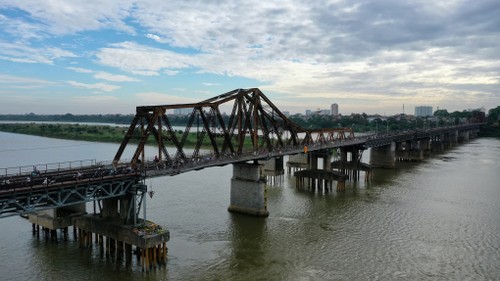 Long Bien bridge spans the two banks of the Red River in Hanoi. (photo: VNA) Long Bien bridge spans the two banks of the Red River in Hanoi. (photo: VNA) |
In the early 20th century, Long Bien bridge was the most massive steel construction in Southeast Asia. It was the first major bridge connecting the two banks of the Red River. The bridge has 19 spans set on 20 pillars, a single railway in the middle, and a lane for bicycles and pedestrians on either side. Long Bien bridge was one of the four largest steel bridges in the world at that time.
Architect Manh Ha said: “It was special because it was built of steel with a total length of nearly 3km spanning the Red River, connecting Long Bien district and Hoan Kiem district. Over the last century, it has played an important role in the lives of Hanoians.”
Long Bien bridge is famous for its role in Vietnam’s history. In the fall of 1954, Long Bien bridge welcomed a victorious army back from Dien Bien Phu to liberate the capital and drive the French colonial army out of Hanoi, down Road 5 to Hai Phong port, and out of Vietnam for good. During the first US bombardment of the north between 1965 and 1968, Long Bien bridge was bombed 10 times by American aircraft, which damaged 7 spans and 4 pillars. During the second bombardment of the north in 1972, bombs were dropped on the bridge four times, destroying two pillars and 1500 meters of the bridge.
Pham Van Ai, an engineer who repaired Long Bien bridge during the war, said: “The main girder of the bridge weighs more than 900 tons. The two side girders are more than 250 tons each. We had to reconnect the main joints of the bridge and repair the road and railway for vehicles and trains.”
Hanoi now has several more bridges spanning the Red River. Long Bien bridge is no longer a major entrance to Hanoi. It is still used, however, by pedestrians, bicycles, motorbikes, and trains.
The sounds and images of trains crossing Long Bien bridge are etched in the memories of many Hanoians.
Mr. Tran Lam, who often bicycles across Long Bien bridge, said: “I’ve known this bridge since my childhood until now. I’m 60 years old. On days when I couldn't cross the bridge because I was too tired or because of the weather, I missed it very much.”
When it was built, Long Bien bridge was called “one of the four biggest bridges in the world” and “the most superb steel construction in Indo-China”. There are now many larger and more modern bridges, but Long Bien bridge is still one of the most famous.
In 2009 and again in 2010, a Long Bien Bridge Festival was held on the bridge, turning it into a crowded walking area and exhibition space.
One tourist said: “It’s really fantastic to walk on Long Bien bridge. Tourists can cycle or drive motorbikes across the bridge. It’s an interesting thing to do when we visit Hanoi.”
Each year the city allocates money to maintain the bridge. It spent 350,000 USD last year and 420,000 USD this year. A major repair in 2015 cost 12.8 million USD. The Department of Railways says it has a plan to repair Long Bien bridge in 2023 to ensure its safe operation until 2030, when urban railway No. 1 will be ready to replace it.
For 120 years Long Bien bridge has witnessed many changes in Hanoi and Vietnam, but the impressive beauty and symbolic importance of Long Bien bridge itself has not changed.